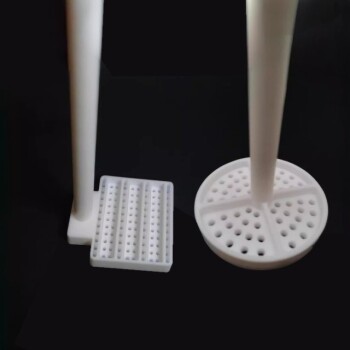The defining advantage of ultra-low temperature (ULT) freezing is its ability to virtually halt all biological activity within a sample. Unlike traditional methods that merely slow down decay, ULT freezers operating at -80°C and below effectively press pause on the cellular and molecular processes that lead to degradation, preserving the sample in a state of suspended animation.
While conventional preservation methods fight a losing battle against time, ultra-low temperature freezing stops the clock. It isn’t just about keeping samples cold; it's about preserving their biological integrity at a molecular level for years or even decades.

The Core Principle: Arresting Biological Time
The value of ULT freezing is rooted in its ability to stop the natural processes that cause biological samples to break down. This goes far beyond what standard refrigeration or freezing can accomplish.
Halting Cellular Metabolism
All living cells, even when frozen at standard temperatures (-20°C), retain some residual metabolic and enzymatic activity. These slow-moving reactions gradually degrade critical molecules.
ULT freezers push temperatures to a point (typically -80°C) where the viscosity of water increases dramatically, essentially locking molecules in place and stopping all enzymatic and metabolic functions.
Preventing Molecular Degradation
Sensitive molecules like RNA are notoriously unstable. They are targeted by enzymes (RNases) that can remain active even at -20°C, rendering a sample useless for genetic analysis.
By arresting all enzymatic activity, ULT storage is the gold standard for preserving the integrity of fragile macromolecules like RNA, DNA, and proteins over the long term.
Key Operational Advantages
Stopping biological time translates into tangible benefits that are critical for modern research, diagnostics, and therapeutics.
Ensuring Sample Integrity and Viability
The primary goal of preservation is to ensure that the sample you thaw is identical to the sample you froze.
ULT freezing maintains the viability of cell lines, the structure of proteins, and the sequence of nucleic acids, ensuring that future analyses are accurate and reproducible.
Enabling Long-Term and Large-Scale Studies
Longitudinal studies, which track subjects over many years, require samples to remain unchanged. Biobanks that store thousands or millions of samples need a reliable preservation method.
ULT storage ensures that a sample collected today will be scientifically comparable to one collected ten years from now, eliminating sample degradation as a variable in the research.
Maintaining Precision and Uniformity
High-quality ULT freezers provide exceptional temperature uniformity, meaning there are no "hot spots" within the unit that could compromise a subset of samples.
This precise temperature control is critical for meeting the strict regulatory and quality standards required in clinical and pharmaceutical environments.
Understanding the Trade-offs
While powerful, ULT freezing is not a universal solution. A clear understanding of its limitations is necessary to use it effectively.
High Energy Consumption and Cost
ULT freezers are significant investments, both in their initial purchase price and their ongoing energy consumption. They represent a substantial operational cost for any laboratory.
Sensitivity to Temperature Fluctuations
The stability offered by a ULT freezer is its greatest strength, but it's also a point of vulnerability. A prolonged power outage or a poorly sealed door can be catastrophic.
For irreplaceable samples, robust backup systems—such as secondary CO₂ or liquid nitrogen (LN₂) injection systems—are not optional, but essential.
The Critical Role of Protocols
Freezing is only half the process. The formation of ice crystals during slow freezing or improper thawing can rupture cell membranes and destroy a sample's integrity.
Strict, validated protocols for both freezing (cryopreservation) and thawing are required to realize the full benefits of the technology.
Making the Right Choice for Your Goal
Your choice of preservation method must align directly with the scientific or clinical goal for your samples.
- If your primary focus is short-term storage of robust samples (days to weeks): Standard refrigeration (+4°C) or freezing (-20°C) is often sufficient and far more cost-effective.
- If your primary focus is the long-term viability of cell lines, tissues, or unstable molecules like RNA: ULT freezing at -80°C or below is the non-negotiable standard.
- If your primary focus is ensuring consistency across a large biobank or a multi-year study: The precision, uniformity, and long-term stability of ULT freezing are essential to guarantee data integrity.
Investing in ultra-low temperature storage is an investment in the future viability and reliability of your most critical biological assets.
Summary Table:
| Aspect | Traditional Methods (e.g., -20°C) | Ultra-Low Temperature Freezing (-80°C and below) |
|---|---|---|
| Biological Activity | Slows down enzymatic and metabolic processes | Virtually halts all biological activity |
| Sample Integrity | Gradual degradation over time | Preserves molecular structure for decades |
| Ideal For | Short-term storage of robust samples | Long-term studies, biobanking, fragile molecules (RNA) |
| Key Limitation | Limited long-term viability | Higher energy consumption and cost |
Ready to preserve your most critical samples with unmatched integrity? KINTEK specializes in providing reliable ultra-low temperature freezers and lab equipment tailored to the demanding needs of research, clinical, and biobanking laboratories. Ensure the long-term viability of your cell lines, tissues, and sensitive molecules. Contact our experts today to find the perfect ULT solution for your laboratory's needs.
Visual Guide

Related Products
- 708L Ultra Low Temperature Freezer High Performance Laboratory Freezer
- 208L Advanced Precision Laboratory Ultra Low Temperature Freezer for Cold Storage
- 608L Essential Laboratory Ultra Low Temperature Freezer For Critical Sample Preservation
- 808L Precision Laboratory Vertical Ultra Low Temperature Freezer
- 28L Compact Upright Ultra Low Temperature Freezer for Laboratory
People Also Ask
- What are the common designs of ultra-low temperature freezers? Upright vs. Chest Models for Your Lab
- What temperature range do Ultra-Low Temperature freezers maintain? The -80°C Standard for Sample Integrity
- What factors should be considered when selecting an ultra-low temperature freezer? Ensure Sample Integrity and Long-Term Value
- In what fields are ultra low temperature freezers most commonly used? Essential for Biomedical, Clinical, and Research Labs
- How do Ultra-Low Temperature freezers ensure the integrity of microbiological samples? Maintain Stability for Critical Research



















